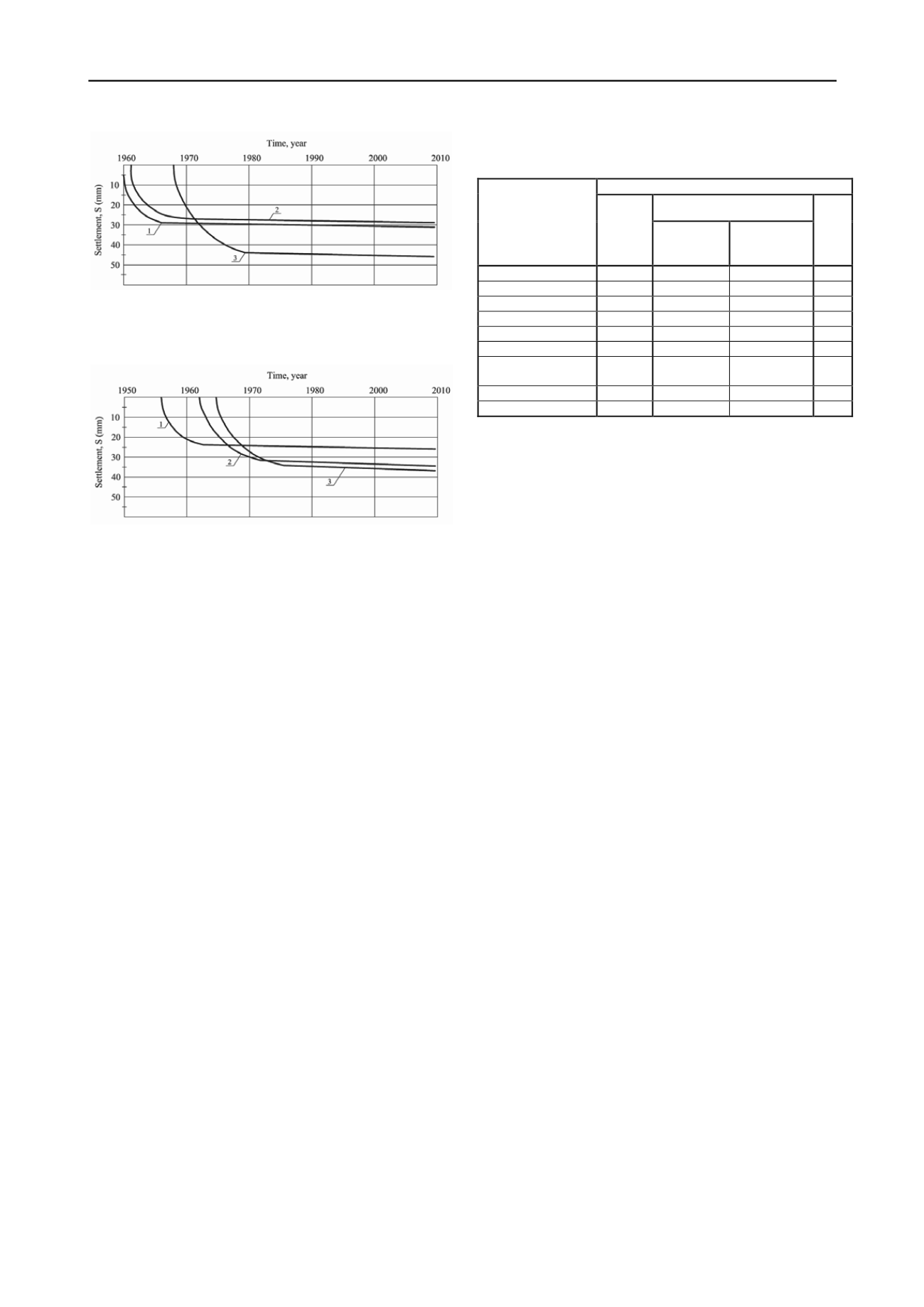
289
Technical Committee 101 - Session I /
Comité technique 101 - Session I
Proceedings of the 18
th
International Conference on Soil Mechanics and Geotechnical Engineering, Paris 2013
Figure 3.
Settlements of charcoal oven batteries over time. 1 – battery
#1, 2 – battery #2, 3 – battery #3.
Figure 4.
Settlements of chimneys over time. 1 - Chimney Н=100m, 2 -
Chimney Н=250m, 3 - Chimney Power Station.
The settlements were calculated based on the design load:
for the blast furnace - 300 t/m
2
, for the chimney - 21.1 t/m
2
, for
charcoal oven battery - 18.0 t/m
2
at the upper edge of the
foundation. The settlements were calculated by the method of
summing the elementary layers and the method of the
equivalent layer in accordance with the building code RK 5.01-
01-2002 "Foundations of buildings and structures." Table 2
provides the comparison of design, actual, and maximum
allowable (by the building codes) settlements.
According to the data provided, the actual foundation
settlements of the industrial projects were several times less
than the design values. As can be seen from Table 2, the actual
settlements of the industrial objects are much lower than the
design and maximum allowable ones: for the blast furnaces 6
17 times; for the oven batteries 2.5
7.0 times; for the Chimney
in 2.5
3.0 times.
It should be noted that the building codes do not take into
account the processes of consolidation and creep of the soil
skeleton over time. The analysis by the method of summing the
layers is based on the half-space elastic models.
The Eurocode 7 “Geotechnical Design” assumes taking into
account the elastic, consolidation and creep components of the
foundation settlements.
The settlements analysis that takes into account creep is the
following:
S =S
0
+S
1
+S
2
(1)
where
S
– total settlements;
S
0
– instantaneous-elastic
settlements;
S
1
– consolidation settlements;
S
2
– creep
settlements (secondary);
Table 1. Comparison of design, actual, and maximum allowable (by
building codes) settlements
Settlements, s, mm
Design
Facility
Actual
Method #1
(layer
summing)
Method #2
(equivalent
layer)
s
u
Blast furnace #1
45
156
210
400
Blast furnace #2
43
163
310
400
Blast furnace #3
55
178
200
400
Oven battery #1
27
138
144
250
Oven battery #2
26
120
132
250
Oven battery #3
44
140
149
250
Chimney (Power
Station)
34
92
103
200
Chimney Н=250 m
32
149
210
200
Chimney Н=100 m
23
83
90
200
The total instantaneous foundation settlement can be
determined by using the elastic theory:
m
E pbf
s
/
0
(2)
where
E
m
– elastic modulus for calculations;
f
– influence factor;
р
– linearly distributed bearing pressure.
The components of the total settlements that take into
account consolidation and creep:
) / ln(
2 1
v
k
v
t t
Hb pHm s s s
(3)
To characterize the intensity of soil creep the creep
parameter
b
κ
is used; it is determined by the compression tests
from the formula:
) / ln( /
v
kt
t t
b
(4)
where
h s
kt
t
/
- creep deformation;
- creep
settlement accumulated during the time
(t-t
v
),
cm;
h-
sample
height, cm;
t
- compression time of the sample from the
beginning of its loading, days;
t
v
– end of consolidation, days.
kt
s
During the construction period (
t
<
t
е
) the applied load is
varying over time. It is appropriate to use the theory of
hereditary creep of Boltzmann-Voltaire for the prediction of
creep settlements under the variable loads (Vyalov S.S. 1978,
Tsytovich N.A. & Ter-Martirosjan Z.T. 1981
)
For the complex load growth pattern and complex core type
of creep, it is convenient to solve the integral equations of the
theory of hereditary creep by the numerical method of Krylov-
Bogoliubov (Ukhov S.B. et al. 2002, Tsytovich N.A. & Ter-
Martirosjan Z.T. 1981, Z.G.Ter-Martirosyan. 1990, Zaretskyi
Y.K.1988, Fadeev A.B. 1987, Zhusupbekov A.Z, Zhakulin
A.S, Orazaly E.E, Popov. V.N. 2001).
6 CONCLUSIONS
1. The long-term field settlement observation for 50 years
provides a great deal of scientific and practical interest.
2. The geotechnical investigations and laboratory testing results
show that the soils underlying the site have relatively high
density and low void ratios. The laboratory studies confirm an
increase in water content of soils and the transition from a semi-
solid to a low-plasticity consistency.
3. The laboratory results indicate that the soils exhibit
gradually decreasing creep behavior.
4. The actual foundation settlements of the industrial projects
were up to 2.5-17 times less than the design and maximum
allowable values based on the building codes.
5. The settlement analysis should take into account the elastic,
consolidation and creep components of the settlements, as well
as make use of elasto-plastic models of the ground.


